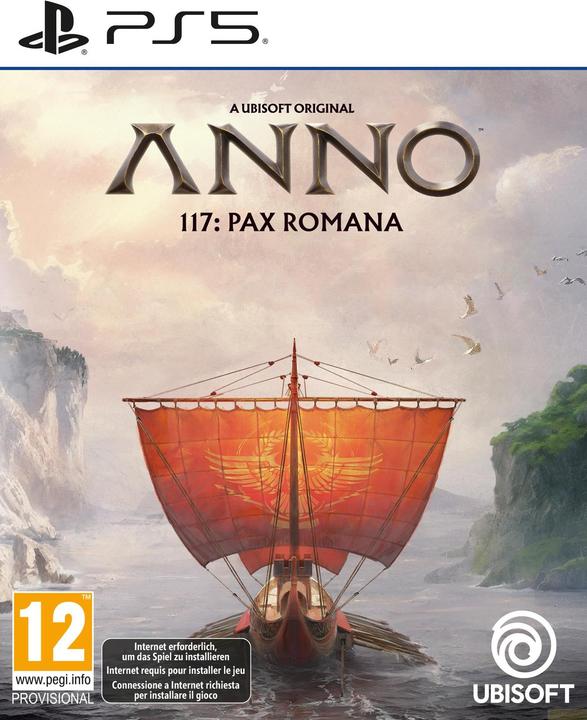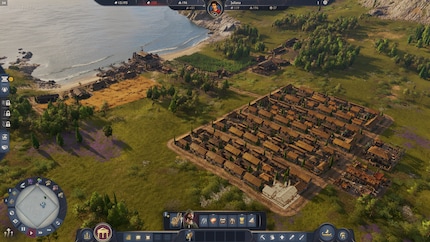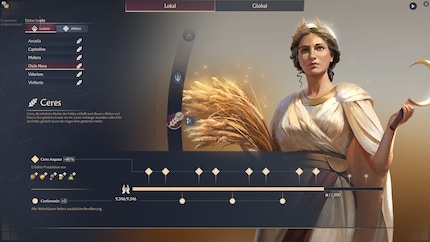

Anno 117 review: reaching a flow state by building in ancient Rome
After more than six years, the successor to Anno 1800 has finally been released. The latest instalment of the series impressed me with a mix of proven principles, fresh ideas and great gameplay.
I gaze upon my empire with pride. A mighty colosseum crowns a nearby hill, my capital below. Noble patricians live here, I’ve moved the rabble to a farming hamlet. My nobles want for nothing: they have bathhouses, temples and libraries. My ships deliver bird tongues in aspic, chariots and colourful togas from distant lands. What a life!
In Anno 117: Pax Romana, I play a newly appointed Roman governor, sent by the Emperor to build up new provinces. This city builder from Ubisoft Mainz is already the eighth title in the series. And it shows: after over 40 hours of gameplay, there’s very little I’d change.
Entertaining campaign to start me off
The campaign begins with a decision. I can slip into either Marcia’s or Naukratius’s sandals. My story starts in Roman Latium, then takes me to Celtic Albion and finally back again. Your choice of character only affects cutscenes, game content stays the same. Of course I won’t mention spoilers here, just a tip: after playing as both, I find Marcia’s storyline more exciting.

Typical for Anno, the general vibe is innocent and child-friendly, yet the campaign is better than in older entries. The beautiful cutscenes also contribute to this. Admittedly, the story doesn’t last particularly long – even at a leisurely pace, I got through it in around six hours. There isn’t much replay value either. This makes the campaign feel more like an appetiser that gradually introduces me to the game mechanics.
Build, expand, optimise
The main course is clearly endless mode. There, I can choose whether to start in Latium or Albion. I opt for the former. As always, the game is based on islands, civilisation tiers and supply chains. With a small starting supply of wood, I build a small village with a few Liberti – inhabitants at the first population level. To become plebeians, they need three things: food, clothing and public services.

I can decide myself how I satisfy their needs. However, my approach does affect my island attributes. If I feed my farmers with sardines, for example, they pay a little more tax. If I give them porridge instead, more people can fit into one house. Optionally, I can also offer them both, earning a bit of each bonus. This makes the most sense for the first two population tiers, since I can produce all goods directly on my island.
With a bigger population, this all becomes more complicated. Firstly, plebeians, equites and patricians have more demands. Secondly, the production chains required to satisfy them become more complex. I might only need one fishery for sardines. But to make lyres for my patricians, I have to mine gold which a blacksmith then melts down into ingots using charcoal. A gilder then uses it to decorate rare sandarac wood before a lyre maker finally uses it to make the instruments. He also needs strings, which a string maker produces out of sheep tendons.

As you’d expect, I can’t find all these goods on my main island. Instead, I have to import them by ship from other islands, even from distant Albion. And different industries work at different speeds to boot. A gold panner has to dig for a whole four minutes before he finds enough nuggets for one unit of gold ore. However, the goldsmith can melt one down in a mere minute. To avoid wasting time, I need to assign four gold panners per blacksmith.
I also have to keep an eye on things like health, happiness and fire safety. Otherwise epidemics, riots and fires will suddenly break out in my cities. The Emperor and other parties also demand my attention from time to time. They demand goods, declare war on me and offer inviting quests.
A rare degree of freedom
If your head’s spinning just reading this, let me reassure you. Firstly, the learning curve is gentle and I’m hardly ever under time pressure. New production chains can be built up one by one at a leisurely pace, and I don’t have to concentrate on ten things at the same time. Detailed statistics are also available to help me keep track of things. There, I can see whether my production roughly corresponds to demand.
Secondly, the system gives me more freedom than older Anno games. I can choose to simply not produce certain goods. For example, I can completely ignore trade between Latium and Albion. I’ll need more complex supply chains if I choose to do so, but transportation delays are shorter in exchange. Or, again, I can do both and get more bonuses. The development team balanced these kinds of decisions so well that every option feels valid.

Another positive I notice in comparison to Anno 1800 and all its DLCs: getting back into the game after a few days’ break is much easier. The scope is more manageable, and I don’t have to remember all my existing production lines. Because once I have a functioning supply chain, I no longer have to keep adding to it as my city grows. Ten thousand patricians only consume slightly more sardines than 500 Liberti – the inhabitants at that higher level do snack on fish from time to time, but mainly eat nobler food.
Overall, Anno 117 feels fluid and well calibrated. I’m challenged, but not overwhelmed, true to the principle «easy to learn, difficult to master». The difficulty level can be adjusted as desired. If you want to settle in comfortably like me, feel free to eliminate disruptive factors such as those annoying pirates. If you want to fight epic battles, you can plant really tough opponents across the map.
Gods, science and war
Military conflicts are atypical for the otherwise peaceful Anno series, but it’s hard to imagine a Roman setting without them. Both on land and at sea, you’ll see legions going at it. Still, don’t expect Age of Empires – the sluggish controls for your troops remind me more of Manor Lords. Battles aren’t bad, but you can tell the developers’ core competencies lies elsewhere. Personally, I prefer resolving conflicts with economic power.

Another new feature is the deities and the technology tree. They both function similarly: residences in the area of influence of a shrine increase faith. The more faith a city has, the greater the bonuses I receive from my patron deity, which I can choose and change at any time. For example, Ceres blesses my agriculture and gives me a population boost. Homes near a Grammaticus produce Knowledge. I can use this to research technologies, such as a greater reach for my marketplaces. The further I work my way up the tech tree, the longer research takes.

With these mechanics, my metropolises can be significantly improved. I pay little attention to them in the first 20 hours of gameplay. All I do is choose the first deity for each island and make sure that research never stops. As is a trend in Anno 117, it’s up to me how much time I put into optimisation. This way, beginners aren’t overwhelmed and professionals can still let off steam.
Pretty, but overly colourful
Latium and Albion look beautiful, both regions offer massive visual variety with realistic lighting effects. People scurry back and forth across my streets, going about their business and making the world feel very alive. The fitting and unobtrusive soundtrack also contributes to this.
Times of day and weather effects are new too. Both are nicely done too, but they don’t get annoying sometimes: nights are too dark for me, sunsets too cheesy, and the frequent rain in Albion makes everything too cloudy. In general, the graphics feel overdrawn and too colourful in places. They sometimes give the game a comic-like look that doesn’t fit with the ancient setting. Fortunately, I only notice this when paying very close attention.

The beautiful graphics also buff up the hardware requirements. Especially if you want to enjoy the game in all its glory at a high resolution, with lots of detail and ray tracing. PC Games Hardware tested various systems and came to a conclusion: Anno 117 needs a lot of GPU power, demands on the CPU are limited. During my test PC with a Radeon RX 7900 XTX, Intel Core i5-13600K and 16 gigabytes of RAM, I achieved a stable 30 fps at 4K with all the bells and whistles, enough for a strategy game.
Anno 117: Pax Romana will be released on 13 November 2025 for PC, Xbox Series X/S and PlayStation 5. The game was provided to me by Ubisoft for testing purposes.
In a nutshell
This game came, saw and conquered
Anno 117: Pax Romana is everything I hoped it’d be. The ancient setting is exactly to my taste. Its campaign is short but entertaining, the gameplay loop is easy to learn but difficult to master. That familiar addictive feeling quickly sets in: even after 40 hours of playtime, I get the irrepressible urge to start a new map and build an even prettier and more efficient city.
Every detail feels well thought out and properly balanced. Thanks to countless quality-of-life features, I can focus on only the exciting things. My city layout, an efficient supply infrastructure and expanding my empire. The new mechanics force me into interesting decisions. Ubisoft Mainz never imposes a particular playstyle on me – instead, I’m always given equal options, all of which have their advantages and disadvantages.
I only have two small points of criticism. Firstly, while Latium and Albion are pretty and lively, they’re a bit too colourful and over the top for my taste. I’d have liked a more serious, less innocent atmosphere. Secondly, I don’t particularly enjoy the combat system with its sluggish controls. However, both hardly cloud my overall impression. For me, Pax Romana is the best Anno of all time.
Pro
- Great setting, pretty graphics
- Outstanding gameplay flow
- Freedom in playstyle
- Little grind
- Interesting new mechanics
- Almost perfectly balanced
Contra
- Slightly too goofy
- Exaggerated graphics
- Plodding combat system

My fingerprint often changes so drastically that my MacBook doesn't recognise it anymore. The reason? If I'm not clinging to a monitor or camera, I'm probably clinging to a rockface by the tips of my fingers.
Which films, shows, books, games or board games are genuinely great? Recommendations from our personal experience.
Show all

